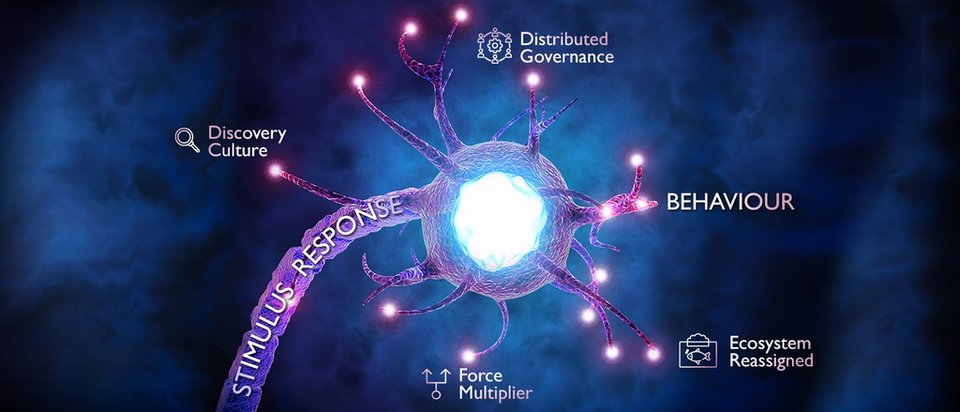foreword
Are you designing for the unconventional?
IKE Institute CEO Professor Sa’ad Sam Medhat offers his advice on how to invigorate your business with innovation as a New Year’s resolution.
As we march into 2022, we invariably feel compelled to make a New Year’s resolution. Perhaps to pursue a new activity, take up a new hobby, or indeed, get rid of an old habit or old thing in the closet.
Of course, for those who have the responsibility of managing a business or a function, such moments of contemplation also create inspirational triggers for what the future might hold or could potentially be for your business.
Thoughts expand, encompassing such poignant questions as: what can we do differently to retain our customers and attract new ones? How can we cut down costs or improve supply chain efficiencies? And, when should such new ideas be introduced?
All of these thoughts and more pop up within the orbit of our imagination, creating a forceful flux of intrigue, excitement and determination enticing us to explore the unconventional.
Over the past twelve months, we at the IKE Institute have experienced an expansive level of interaction with wide ranging businesses of all sizes, as well as from governmental organisations from around the world. An interesting watershed moment has arisen!
Increase your innovation velocity
We’ve noticed that, despite the apparent drive by many organisations for business process transformation to arrest the exasperated level of burden, and the urgency for change that the Covid-19 pandemic has imposed upon us, many still struggle to increase their innovation velocity and deliver the desired level of value creation.
The new definitions of working models, such as hybrid working and the associated reconfiguration of the office footprint, together with the accelerated push for digital investment to enable growth in products and services, has presented a selection of effectiveness and efficiency priority measures that businesses have had to enact.
So, why have so many businesses encountered such lame outcomes when it comes to delivering desired value?
A lack of cultural preparation might have created an anti-gravitational force within some businesses, thereby restraining business outcomes from reaching their intended value.
On closer examination, to identify some of the root causes of those inconclusive business outcomes, what has emerged through our benchmarking efforts is that, in most cases, the strategic decision-making processes seem to be incompatible with the pace of ongoing challenges of today’s rapidly changing operating environment.
In the vast majority of businesses, the culprit of these enervated outcomes was found to be a lack of having the right business intelligence that offered a combination of analysis, modelling and benchmarking, at the point of decision-making.
Not having an even platform of common innovation understanding has also been identified as an attributive cause. Furthermore, a lack of cultural preparation might have, inadvertently and unconsciously, created an anti-gravitational force within some businesses, thereby restraining business outcomes from reaching their intended value.

Embrace the unconventional to advance your business goals
Activating such an intelligent decision-making approach requires business leaders to embrace a new form of behaviour. If one subscribed to the well-established psychological notion of behaviour, defined as the result of a stimulus-response (Thorndike, Edward L.,1904 and Pavlov Ivan P., 1927), then, just like the New Year’s resolution, the stimulus here is about the need to revitalise the business environment enabling it to access the required intelligence in a streamlined and timely way to inform decision-making.
One could claim that the solution to such challenges could be resolved through deployment of some of today’s sophisticated analytics tools and platforms inculcating different forms of artificial intelligence and machine learning. However, whilst the supposition of deploying business intelligence tools is a valid one, with the potential to result in significant improvements, the attaining of desired-yield outcomes may still not be reached.
It's in this spirit of true advancement of business goals, that we offer some practical thoughts to remedy the aforementioned challenges:
1. Fostering a discovery culture
Continuously reinvigorating a business environment requires a business leader to encourage a mindset of a ‘discovery culture’ that continuously initiates a ‘what if’hypothesis to exploit and explore new sources of value capture and value creation. Perhaps this could be voted as a New Year’s resolution.
This approach would require a business leader to design-in experimentation as an empowerment tool, creating the cultural hacks needed to mobilise fast experiments to explore and exploit new ways to create and optimise value. Small-scale experimentations often succeed and can enable an organisation investing in new a venture to learn what works, and, at what scale, as well as, uncovering those potential latent opportunities.
Evidence shows that businesses who have designed-in their innovation experiments, particularly in times of crisis or when they’re experiencing an inflection point, have been able to adapt, transform and respond more quickly to shifting customer and user needs, and leverage new opportunities that have been created by the changing landscape (McKinsey, Crisis Survey 2020; OECD Science, Technology and Innovation Outlook, 2021).
This mindset of a ‘discovery culture’ is as much applicable to a business as it is to any individual making their own self-promised pledge.
In encouraging a discovery culture, it is important for a leader to shift thinking from just the incremental adjustments of products and services to that of what can be done with newly discovered technologies and capabilities over a longer horizon. This is where bravery is greatly needed to balance the demands on resources for delivering the current business operational requirements, with those potential opportunities yet to be tapped.
2. Distributed governance
The hard-wired one-size-fits-all governance diktat has very limited room in today’s highly volatile business environment. Shifting emphasis from top-down governance to that of ‘distributed centres of excellence’ is what should be encouraged to enable conventional, passive and compliance-oriented decision-making approaches to move to that of more unconventional, active and sensitive approaches that fold in opportunity and balanced risk.
If the previous point of fostering a discovery culture was to be embraced, then migration towards a more distributed process of governance, combining both formal and informal decision-rights that are connected to value, would be a natural step towards intelligent decision-making.
It is worth pointing out that to operate distributed governance effectively, the strategic direction of travel and a set of well-communicated operating principles need to be established to ensure the risk thresholds are defined for the business. Here, the combined use of coaching and mentoring can be put into powerful effect to improve confidence in strategic management.
3. Gain a force multiplier through innovation training
Enabling and empowering an ethos of cross-functional culture that embraces rapid discovery – innovation by instinct – will require an intensified attention to the provision of innovation training and development, to ensure consistency in understanding and enhanced capability to execute on high-value opportunities.
This is a foundational element business leaders should consider as part of creating the much-needed adaptive capacity in business – from articulating sources of growth and truly understanding customer current and latent needs, to that of optimising strategy processes, calibrating strategic responses, evaluating and realigning capabilities, and even acquiring new ones.
4. Reassigning the role of your ecosystem
Leveraging collaboration to yield more meaningful insights for a business, its customers and stakeholders, will require a more effective, design-led formation of its network of actors and influencers that normally contribute to the creation and capture of business value – the business ecosystem.
We’re already witnessing competitors and non-traditional partners becoming collaborators and co-creators at a sector level, addressing big challenges that affect many businesses. Such collaborations help to drive the pursuit of risk reduction and the development of rapid discoveries and breakthrough innovations.
From incremental through to more strategically focused disruptive innovations, a business will need to be conscious and deliberate about the accountability requirements it imposes on its stakeholders and ecosystem partners to ensure that those new changes stick, and ultimately, generate the desired yield value (e.g. growth).
Blurring the lines between products, services, and user environments is evident, and is particularly apparent when it comes to the expansive use of digital technologies and applications. This confluence means that an organisation will need to test the feasibility of new and emerging technologies, and design-in new ‘unconventional scenarios’ where, for example, the customer or user could potentially be a machine or a device. Here, the role of data and analytics in informing business intelligence can significantly improve the quality and speed of decision-making, even if the opportunities are not readily visible.
Allowing serious time for evaluating sprint experiments is a necessary step in ensuring new lines of growth can be borne, and preventing the business from reverting back to its comfort zone position of predictable incremental enhancements and well-known adjacencies.
Accomplishing optimum results can be achieved from innovation-driven transformation. And, indeed should be on your New Year’s list of resolutions. However, a rethink of how we view work, how we define our business value, how we motivate people to explore the art of the possible, and how we lead, may require us to extend our orbit of imagination further to hypothesise the unconventional in order to spot those optimum opportunities!

Professor Sa’ad Sam Medhat
PhD MPhil CEng FIET FCIM FCMI FRSA FIKE FIoD
Chief Executive
Institute of Innovation and Knowledge Exchange